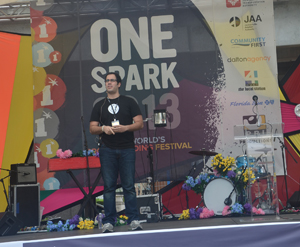
Everyone wants a “startup” these days. Everyone wants to be a “founder” with little more than a concept, an LLC filing, some Web real estate, and a dream. But how do you really get it done? In early stage brand building, traction is king.
You’ve likely seen the HBO Series “How To Make It in America.” It chronicles the story of two co-founders and their group of friends. There is luck, drama, rejection, implied success, real success, good marketing, poor marketing, and more luck. As difficult as they make it look in that wonderful series, they actually make it look easy. In reality, think less partying, more planning, and little dependence on gimmicks and luck. This being said, with the right approach it can be done. There is still room for innovation in textile manufacturing and fashion branding.
Starting a clothing brand can be one of the most worthwhile pursuits in all of startups. There are elements of: manufacturing, design, communication, marketing, probability and statistics, industrial engineering, timing, and the almighty of them all — foresight. There are so many variables that go into a success or failure. Right now (and I repeat, right now), we are somewhat succeeding. That being said, I thought I’d share some helpful hints.
Proof of Concept
Before a single shirt was manufactured, we had our initial concept feedback. “So, let me get this this straight,” the industry executive said. “You are going to manufacture in the States? You are going to use American-sourced fabrics? And you think you’re going to succeed in the textile industry?” Well, yes.
From July 2012 and through the fall, we focused on sales, feedback, construction revision, and regional media. Between Kevin and I, we bore the brunt of these tasks. Validation via earned media was the most difficult day-to-day task.
Through this initial stage, we were purely focused on “proof of concept” in our first test market — Dallas, Texas. The media response was great! And so, we continued. Active, driven, and confident men do want something more from their dress shirts.
Spring for Traction
After starting up in April of 2012 and launching the website in July 2012 (with only one product), we are now finally leaning into the Spring of Traction. Through the summer, fall, and winter of 2012, we were silently working on perfecting our first pieces, ginning up “first adopter” sales, building relationships, establishing brick and mortar presences, improving our supply chain, not paying ourselves, and paying our taxes. With that behind us, the fun begins. This spring is focused on the push for traction.
After the foundation that we’ve set over the past year, we can begin focusing on the brand’s opportunity and/or visibility to grow within several of our proven early-adopter demographics: professional athletics, military, collegiate, and metropolitan business.
The “How To” of This Blog
What does all of this mean to a young brand? It is a meticulous process that involves quite a bit of sacrifice, help, influence, and yes, just a little bit of luck. Here are some great tips that few in the industry will share:
- Start with a concept that no one else is willing to attempt. Remember, it’s even better when people tell you, “Based on the industry precedent, this likely won’t work.”
- The design and manufacturing process is expensive. Allot $20k-$50k for your first product run. You will need to achieve a volume of units manufactured to achieve reasonable margins.
- Spend money on your branding and your collateral. I can’t say this enough.
- Understand your supply chain and have a manufacturing backup plan when those sources, printers, and cut and sew shops are over capacity.
- Spend money on your brand’s website and branding videos.
- If you didn’t attend a top fashion design program, find a top designer who did and hire that person. Find a way to get that person on your team.
- If there are no other options at the start, plan on pouring all of your personal income into the project for the first year or two.
- Keep these elements at the forefront: be first to market, drive sales, gain traction.
- Customers aren’t free. Find a natural pipeline that will serve as high-conversion customer acquisition.
- Ask for help and be willing to pay for it.
The market is always looking for the next great idea; be willing to sacrifice to see it through. Design really well, depict great logo and lifestyle imagery, prove your concept in a transparent way, and then focus on gaining traction as you go. When you need the push, find a well-connected and cost-effective way to move your brand forward.
This post originally appeared on the author’s blog.
Web Smith is a Sr. Analyst, Co-Founder, and Sports / Entertainment / Political Marketing Consultant and a student of strategy. Follow him at: http://www.twitter.com/web.
The Young Entrepreneur Council (YEC) is an invite-only organization comprised of the world’s most promising young entrepreneurs. In partnership with Citi, the YEC recently launched #StartupLab, a free virtual mentorship program that helps millions of entrepreneurs start and grow businesses via live video chats, an expert content library and email lessons.
 Companies like Netflix, Amazon Prime and Hulu have started making a dent in traditional cable tv consumption. More and more people, globally, are watching tv shows and movies on other screens like, laptops, mobile phones and tablets. This has caused most cable companies (especially in the US) to move to other sources for revenue like telephone lines and cable internet.
Companies like Netflix, Amazon Prime and Hulu have started making a dent in traditional cable tv consumption. More and more people, globally, are watching tv shows and movies on other screens like, laptops, mobile phones and tablets. This has caused most cable companies (especially in the US) to move to other sources for revenue like telephone lines and cable internet.

















